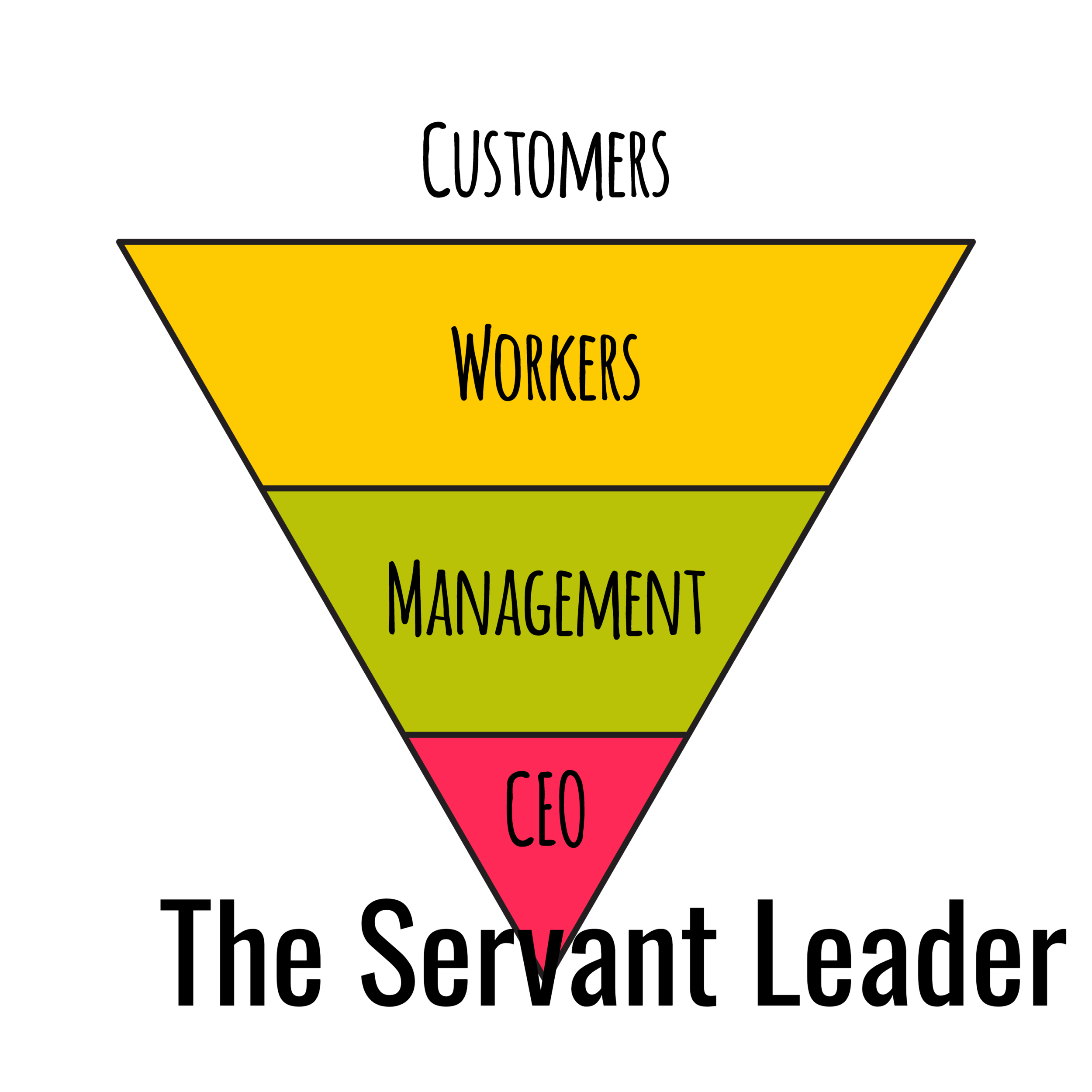- Origin of the Servant Leader notion
- The manager must be at the service of his clients and his team. And not the opposite
- How does servant leadership empower teams?
- Why serve…?
- Serving others is certainly an epic
- Servant Leader and management 3.0
- Other avenues to explore
- Towards a living management
- Self-determined team
- Being an actor
- Agile culture, a learning company?
- Agile News
The Servant Leader is a leader or manager serving his subordinates to help them accomplish the common goal.
The servant Leader thus marks a transition in managerial models by breaking the traditional links of subordination in the prioritization of interactions between the stakeholders of an organization.
Origin of the Servant Leader notion
Among the few innovative and alternative leadership philosophies that have emerged, particularly in the last third of the twentieth century, it is worth mentioning: the concept of a “learning organization” (Senge, 1990 & 1999; Belet, 2002), that of “emotional intelligence” (Goleman, 1995; Goleman, Boyatzis, McKee, 2002) and finally the one that particularly interests us here: “servant leadership” (Neuschel, 1998; Spears & Lawrence, 2002; Frick, 2004 )
The concept was first proposed in the 1970s by Robert Greenleaf, its inventor and arguably its most famous promoter, is a human resources executive at the American company ATT.
He proposed the term “servant-leadership” to characterize him in the late 1970s and formalized its philosophy and principles of action. The notion of servant leadership is revolutionary by the inversion of the hierarchical links that we usually know.

The manager must be at the service of his clients and his team. And not the opposite
The Servant Leader perspective revolutionizes the managerial posture by reversing priorities.
Until then, labor relations in companies remain marked by a deep division as much as unconscious: the managers endowed with the authority and the collaborators who are supposed to serve under this authority. Servant Leadership is the opposite.
A servant leader is at the service of his team which is itself at the service of its customers. The underlying model is based on the idea of trust in humans.
This division is formalized by employment contracts, job descriptions, and even by law. For example, the CEO is at the service of shareholders. If he is missing from this service, he is revocable without explanation. Subconsciously, and at least in part, we continue to convey and perpetuate this division taught by ancient texts, which described a world of masters and slaves.
How does servant leadership empower teams?
Servant leaders, or facilitating managers, consider their teams as the first priority, before the company’s objectives and their own personal objectives.
The servant leader’s mission is the personal growth of his or her employees, so that they themselves can become servant leaders in the future.
The encouraging posture of this type of management allows a real growth of the autonomy of the teams. Servant leadership results in more creativity and a better ability to solve problems.
Why serve…?
Managerial and organizational practices create today a growing number of “managerial pathologies” or serious dysfunctions such as chronic malaise of management, a climate of mistrust towards the hierarchy, increasing psychosocial risks, demotivation and disengagement of employees, a lack of cooperation especially within work teams, various rivalries and conflicts, a deleterious work atmosphere, etc. ..
The costs associated with these dysfunctions can no longer be ignored and invite companies to transform … QUICKLY!

In the traditional business approach, the business is first and foremost a profit-making machine operating primarily according to a managerial and productivist logic. Employees are considered as means or cogs supposed to accomplish a certain number of tasks pre-defined by the hierarchy for its proper functioning.
This approach is reflected in: pyramidal organization charts, very hierarchical and “top down” management methods, centralization of decision-making processes, organization in pre-defined work “stations”, inflation of reports and other controls, bureaucratic operation, submission of the employees’ work on operating processes restricting their margins of initiative, focusing only on economic and quantitative objectives, etc.
The “servant leadership” paradigm offers a very different approach to leadership by reversing the communication relationship between the different stakeholders.
Opposing decentralization of decisions and a participatory decision-making process, to compliance and a lack of criticism of directives from the top of the hierarchy, for fear of its reactions.
Some intelligent and responsible “manager-leaders” are beginning to realize that these traditional methods of managing people must change profoundly. They understand that they will achieve their strategic objectives even better if they are more attentive to people and their environment. Therefore, they feel it is necessary to “humanize” men’s management practices more through more listening and dialogue, through the creation of a climate of trust, through greater delegation and accountability, through the encouragement of initiative and creative ideas, etc.
Some have gone further by emphasizing the principle of a real responsibility of line managers in terms of service towards their employees. They advocated a sort of upside down hierarchy that involves “overthrowing the pyramid” and which has proven its operational effectiveness, as the experience of SAS in the 1980s showed!
Serving others is certainly an epic
Robert Greenleaf advises, “My advice is that anyone who sets out on a journey of service to others must learn that the journey is, of necessity, a long, long journey. And on that journey, there will be successes, but also a lot of mistakes and errors made!
Greenleaf criticizes a belief: the notion of providential man who straightens the business by his genius. He questions the notion of the leader-hero, knowing how to overcome the adversity of difficult situations to become a sort of “savior” of the organization for the benefit of a learning organization which relies on the key skills of the constituent men in the team.
On the contrary, he explains, a “manager-leader” who sees himself first and foremost as a “servant” of his organization and his troops will play another role and adopt completely different and more effective attitudes and behaviors than those. of a traditional manager. The “servant-leader” listens – questions – transforms so that the people at the heart of the action, of the problems that they are organizational, take their responsibility, and are free to put in place the adapted solutions.
Servant Leader and management 3.0
The notion was taken up by Agile teams in the 2000s, notably with the notion of leader gardener. the latter takes up the challenge of a more responsive company, with a greater ability to adapt, promoting time-to-market.
The Agile organisation must:
- Foster l’innovation
- Listening to weak signals
- Unlock everyone’s potentials
- Respond to increasingly complex and varied requests
- Promote professional development and QWL
- Embrace societal issues
- Dealing with complexity and increased competition
- Increase motivation and give meaning to the action
- Mobilize the new generations
- Facing the new economic challenges of companies
Other avenues to explore
Towards a living management
Self-determined team
Being an actor
Agile culture, a learning company?
Training program Agile 3M
3 Programmes de Formations Agile 3 M Agile fait partie des parcours Trans’Formations Ago Apprendre en expérimentant .…Demandez un devis Un conseilDémarche Trans’Formation
Agile News
Découvrir le Manifeste Agile- 4 valeurs et 12 principes interprétés selon 3 focus : individuel, équipe, organisation LE MANIFESTE
Retour d’expériences,
Œil de coachRETEX
Retrouver tous les articles
et outils liés à l’AgilitéAGILITE

